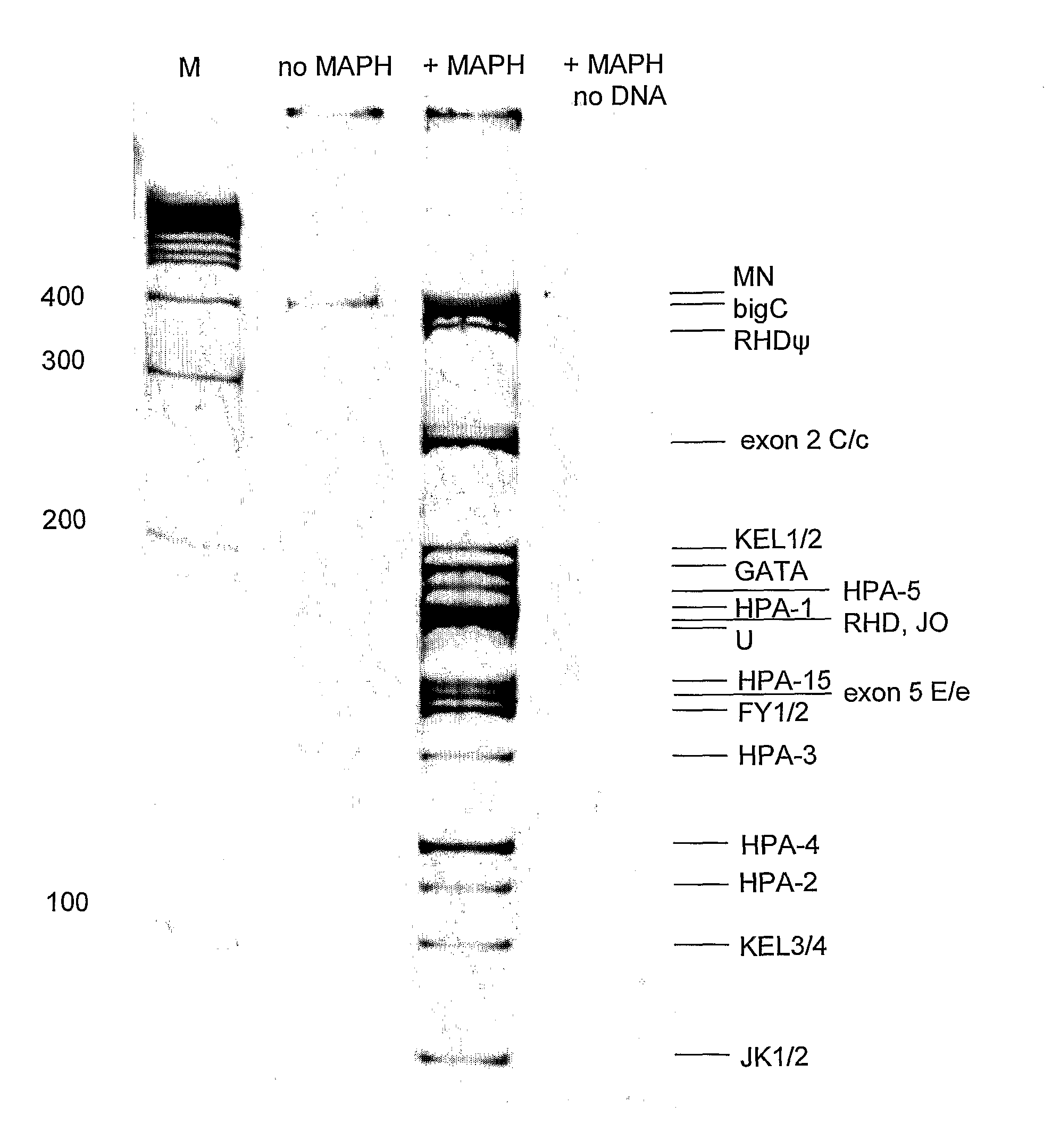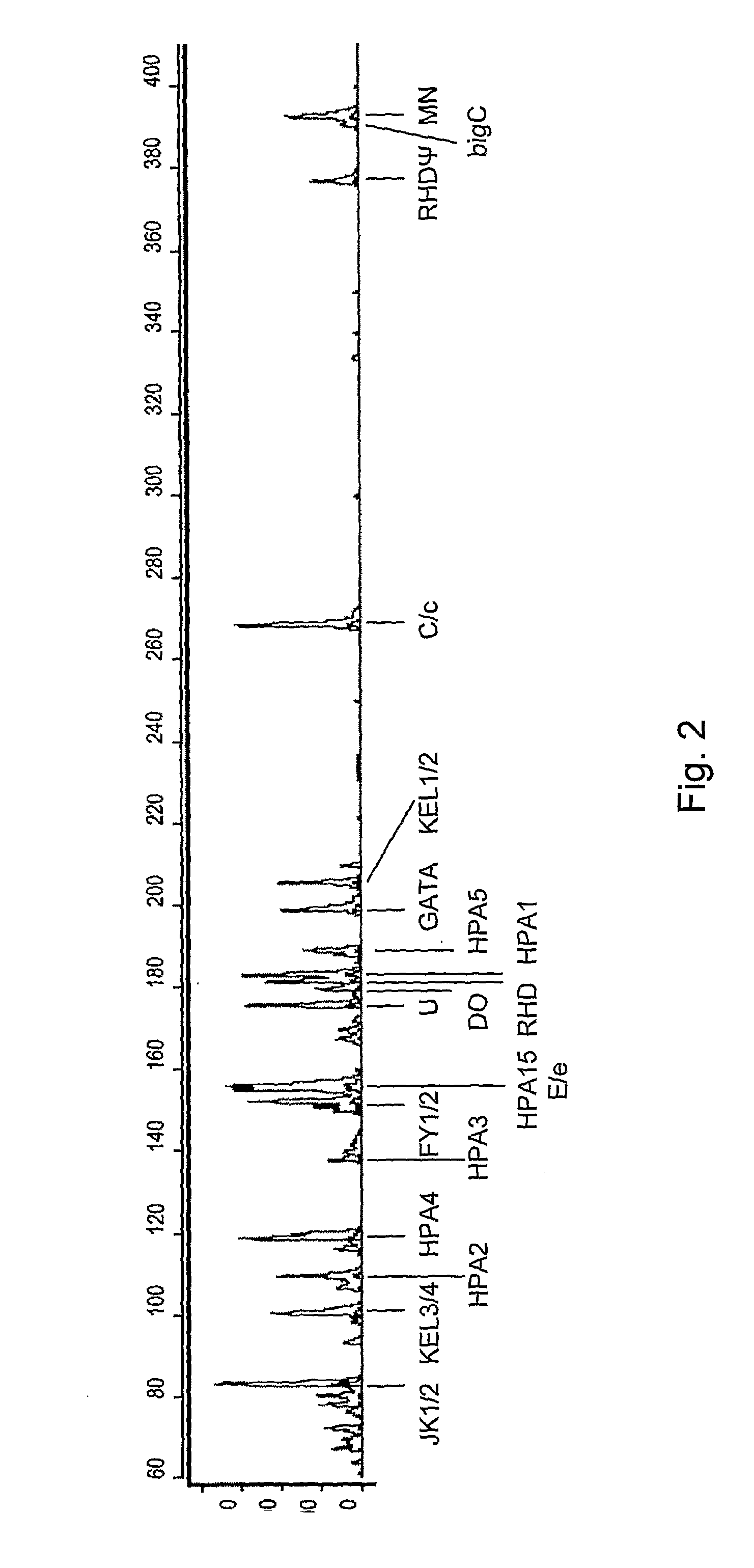Method of Genotyping Blood Cell Antigens and Kit Suitable for Genotyping Blood Cell Antigens
a technology kit, which is applied in the field of blood cell antigen genotyping and kit suitable for genotyping blood cell antigen, can solve the problems of high chance, donor blood or blood fraction does not exist, and serious adverse reactions may occur, so as to achieve rapid and reliable genotyping, the effect of practicality
- Summary
- Abstract
- Description
- Claims
- Application Information
AI Technical Summary
Benefits of technology
Problems solved by technology
Method used
Image
Examples
example 1
[0075] Sequences and Tm values of the probes spotted on poly-Lysine-coated glass slide are shown in Table I. The SNPs of HPA-3 and -5 are located in a GC-rich and -poor area, respectively. Therefore, these probes are shorter or longer than the other oligonucleotides, and have a Tm outside the 60-65° C. range. The probes, dissolved at a concentration of 50 μM in 0.4 M NaHCO3 (pH 9.4), were spotted on poly-L-lysine coated glass slides by the Omnigrid 100® microarrayer (Genemachines) supplied with 16 SMP 3 Microspotting pins (Telechem). Each glass slide contains 48 blocks of 134 spots corresponding to the 128 allele-specific probes, the 5 background controls and the positive control CS05. Similar probes were spotted as distant as possible from each other. DNA was cross-linked by UV irradiation at 250 mJ / cm2 (Stratalinker model 1800 UV Illuminator, Stratagene). To prevent non-specific hybridisation, the slides were incubated with 100 μl of prehybridisation solution [400 ng / μl yeast tRNA...
example 2
[0077] A primer mix was constructed with the primers listed in Table II. The concentration of the primers in the PCR mixture is also listed in Table II. The Qiagen multiplex kit was used for the multiplex PCR. In the multiplex PCR, the annealing temperature was not changed during PCR and two fluorescent labelled universal primers were used. In more detail, at the start the PCR mixture contains a very low amount of chimeric primers (5 nM) and an excess of fluorescent-labelled universal primers (0.2 μM of each universal primer per chimeric primer). The temperature profile of the PCR started with 15 min at 95° C., followed by 45 cycles of 94° C. for 30 sec, 57° C. for 90 sec, 72° C. for 90 sec and the protocol ended with a final polymerization step at 72° C. for 10 min. Very little amount of PCR product is amplified during the first amplification cycles, but enough to be used as template by the universal MAPH primers in the following cycles as can be seen on 8% acrylamide gel in FIG. 1...
PUM
| Property | Measurement | Unit |
|---|---|---|
| temperature | aaaaa | aaaaa |
| temperature | aaaaa | aaaaa |
| temperature | aaaaa | aaaaa |
Abstract
Description
Claims
Application Information
 Login to View More
Login to View More - R&D
- Intellectual Property
- Life Sciences
- Materials
- Tech Scout
- Unparalleled Data Quality
- Higher Quality Content
- 60% Fewer Hallucinations
Browse by: Latest US Patents, China's latest patents, Technical Efficacy Thesaurus, Application Domain, Technology Topic, Popular Technical Reports.
© 2025 PatSnap. All rights reserved.Legal|Privacy policy|Modern Slavery Act Transparency Statement|Sitemap|About US| Contact US: help@patsnap.com



